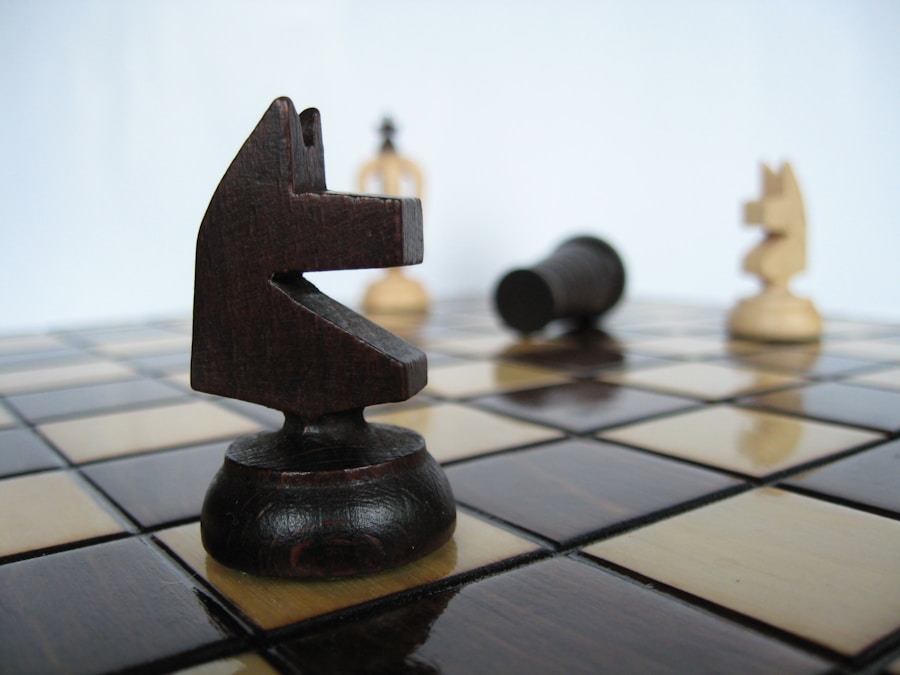Download links
How to install Mastering the Art of Chess: Strategies for Success APK?
1. Tap the downloaded Mastering the Art of Chess: Strategies for Success APK file.
2. Touch install.
3. Follow the steps on the screen.
Description
Chess is a two-player strategy board game that has captivated minds for centuries. The game is played on an 8×8 grid, known as a chessboard, where each player commands an army of 16 pieces: one king, one queen, two rooks, two knights, two bishops, and eight pawns. Each piece has its own unique movement rules, which contribute to the complexity and depth of the game.
The objective is to checkmate the opponent’s king, meaning the king is placed in a position where it cannot escape capture. This fundamental goal drives all strategies and tactics employed throughout the game. Understanding the basic rules and movements of each piece is essential for any aspiring chess player.
The king moves one square in any direction, while the queen can move any number of squares along a rank, file, or diagonal. Rooks move in straight lines along ranks and files, bishops traverse diagonals, and knights have a unique L-shaped movement that allows them to jump over other pieces. Pawns move forward one square but capture diagonally, and they have the special ability to advance two squares on their first move.
Familiarity with these movements lays the groundwork for more advanced strategies and tactics that players will encounter as they progress.
Key Takeaways
- Chess is a game played on an 8×8 grid with 16 pieces on each side, and the goal is to checkmate the opponent’s king.
- A strong opening strategy involves controlling the center, developing pieces, and protecting the king.
- Tactical play involves creating threats and opportunities, while positional play focuses on long-term advantages and piece placement.
- Endgame techniques include king activity, pawn promotion, and creating passed pawns.
- Improving decision making and calculation involves evaluating different options and accurately predicting the consequences of each move.
- Studying grandmaster games can help players understand advanced strategies and improve their overall game.
Developing a Strong Opening Strategy
The opening phase of a chess game is crucial as it sets the stage for the middle game and ultimately influences the endgame. A strong opening strategy involves controlling the center of the board, developing pieces efficiently, and ensuring the safety of the king. Controlling the center allows for greater mobility and flexibility in piece movement, which can lead to tactical advantages later in the game.
Players often aim to occupy central squares with pawns and develop their knights and bishops to exert influence over these key areas. One popular opening strategy is the “Italian Game,” which begins with 1.e4 e5 2.Nf3 Nc6 3.Bc4. This opening focuses on rapid development and control of the center while preparing for potential attacks on the f7 pawn, which is often a weak point for Black in the early game.
Another well-known opening is the “Sicilian Defense,” initiated by 1.e4 c5. This response allows Black to counterattack and create asymmetrical positions that can lead to dynamic play. By studying various openings and their underlying principles, players can develop a repertoire that suits their style and enhances their overall performance.
Mastering Tactical and Positional Play

Tactical play in chess involves short-term calculations and combinations that can lead to immediate advantages, such as winning material or delivering checkmate. Recognizing tactical motifs like forks, pins, skewers, and discovered attacks is essential for players looking to improve their game. For instance, a fork occurs when a single piece attacks two or more enemy pieces simultaneously, forcing the opponent to make difficult choices about which piece to save.
Mastering these tactics requires practice and familiarity with common patterns that arise in various positions. Positional play, on the other hand, focuses on long-term strategic considerations rather than immediate gains. It involves evaluating the strengths and weaknesses of both players’ positions and making moves that improve one’s own position while restricting the opponent’s options.
Key concepts in positional play include pawn structure, piece activity, and control of key squares. For example, a strong pawn structure can provide a solid foundation for launching attacks or defending against threats. Players must learn to balance tactical opportunities with positional considerations to become well-rounded competitors.
Utilizing Endgame Techniques
| Endgame Technique | Success Rate | Usage Frequency |
|---|---|---|
| King and Pawn vs. King | 85% | High |
| Rook Endgames | 70% | Medium |
| Bishop and Knight Checkmate | 60% | Low |
The endgame is a critical phase of chess where fewer pieces remain on the board, and precise calculation becomes paramount. Understanding endgame techniques can often be the difference between winning and drawing or losing a game. One fundamental concept in endgames is the importance of king activity; unlike in the opening and middle game where the king is often kept safe behind pawns, in the endgame, it becomes an active piece that can help support pawn promotion or defend against threats.
Common endgame scenarios include king and pawn versus king, where the player with the extra pawn must navigate carefully to promote it while preventing the opponent’s king from blocking its path. Another classic endgame is the rook versus pawn endgame, where players must understand how to use their rook effectively to cut off the opposing king while supporting their own pawns’ advancement. Mastering these techniques requires practice and an understanding of theoretical positions that frequently arise in endgames.
Improving Decision Making and Calculation
Effective decision-making in chess hinges on a player’s ability to evaluate positions accurately and calculate variations deeply. This process involves assessing potential moves based on factors such as material balance, piece activity, king safety, and pawn structure. Players must learn to weigh these factors against one another to determine which move offers the best prospects for success.
Developing this skill often requires extensive practice and experience in various positions. Calculation is another critical aspect of decision-making in chess. It involves visualizing potential sequences of moves several steps ahead while considering both one’s own plans and the opponent’s responses.
Strong players often employ techniques such as “candidate moves,” where they generate a list of plausible moves before calculating their consequences in detail. This method helps streamline the decision-making process by narrowing down options based on initial evaluations before delving into deeper calculations.
Studying and Analyzing Grandmaster Games

One of the most effective ways to improve at chess is by studying games played by grandmasters. These high-level players often demonstrate advanced strategies, tactics, and techniques that can provide valuable insights for aspiring players. Analyzing grandmaster games allows players to see how top competitors handle various positions, make decisions under pressure, and execute complex plans.
When studying grandmaster games, it is beneficial to focus on specific themes or concepts within each game. For instance, players might analyze how a grandmaster transitions from the opening into the middle game or how they handle tactical complications during critical moments. Additionally, reviewing annotated games—where grandmasters provide commentary on their thought processes—can offer deeper understanding of strategic ideas and decision-making frameworks.
By immersing themselves in high-level play, aspiring chess enthusiasts can elevate their own understanding of the game and refine their skills over time.
If you’re a fan of chess, you may also enjoy reading about the strategic battles in the Marvel universe. Check out this article on Marvel Batalla de Superheroes 2 to see how superheroes use their powers to outwit their opponents. Just like in chess, each move must be carefully calculated to achieve victory.
FAQs
What is chess?
Chess is a two-player strategy board game that is played on an 8×8 grid. It is one of the most popular and enduring games in the world, with a rich history dating back over a thousand years.
How is chess played?
Chess is played on a square board divided into 64 squares, with each player starting with 16 pieces: one king, one queen, two rooks, two knights, two bishops, and eight pawns. The objective of the game is to checkmate the opponent’s king, which means putting the king into a position where it cannot escape capture.
What are the basic rules of chess?
Each type of chess piece moves in a specific way, and players take turns moving their pieces across the board. The game ends when one player’s king is in checkmate, or when a stalemate is reached.
What are the benefits of playing chess?
Chess has been shown to have numerous cognitive benefits, including improving memory, concentration, problem-solving skills, and strategic thinking. It is also a great way to improve patience and decision-making abilities.
What is the history of chess?
Chess originated in India around the 6th century and spread to Persia, where it became known as “shatranj.” It then spread to Europe and evolved into the modern game of chess that we know today.
Are there different variations of chess?
Yes, there are many variations of chess, including speed chess (blitz and bullet), chess960 (also known as Fischer Random Chess), and team chess (such as bughouse or team relay chess). Each variation has its own unique rules and strategies.





